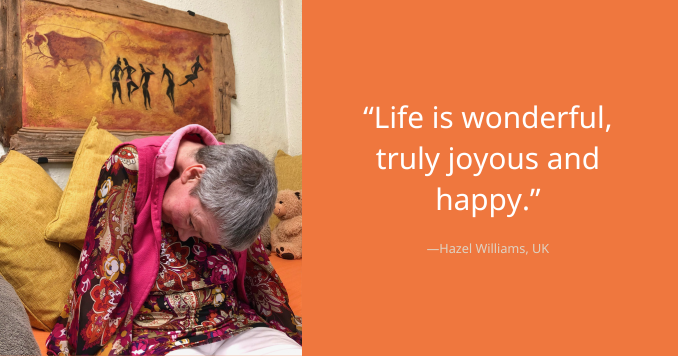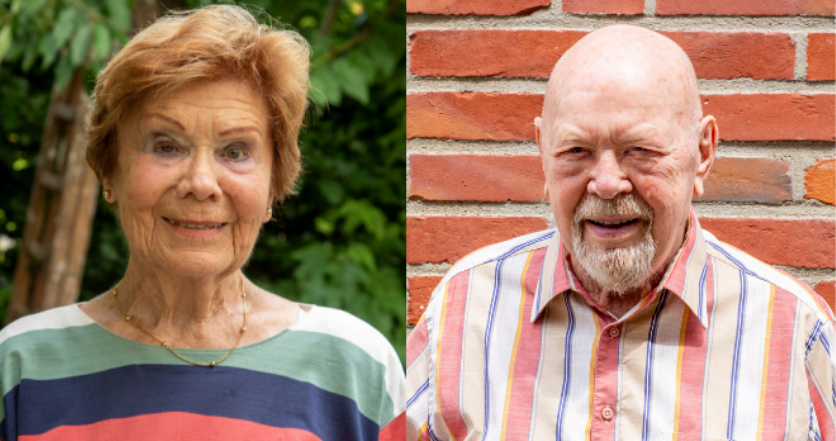Living Every Moment to the Fullest

Hazel Williams, from the UK, describes her journey with a rare condition and how her Buddhist practice helps her find joy every day.
I was introduced to Nichiren Buddhism around 12 years ago by an amazing gentleman who was totally blind and a real inspiration to others. When we chatted, something really resonated inside of me. I wanted some of his positivity, his joyous seeking attitude and zest for life.
Going to study and discussion meetings, where I could deepen my understanding of Buddhist philosophy and talk about life, filled me with a new vibrant energy and enthusiasm that I hadn’t felt before, and I realized I could turn my life around—which I certainly have.
Over the next few years, I attended every SGI-UK meeting I could. Members oozed dynamic energy, perseverance, courage, strength and also a sense of real joy and happiness. They were like my guiding lanterns in the dark, illuminating my way and their support was like the interconnected roots below a tree.
It was so lovely to have heart-to-heart conversations and meaningful dialogues. I loved discussion meetings, finding out how members had used their Buddhist practice in their daily lives to overcome difficult challenges and still be positive.
Facing an Incurable Disease
I have had quite a few health problems over the course of my life. Six years ago, my physical health rapidly declined, and after two years, the doctor told me there was no cure and all they could do was make me as comfortable as possible. I have a rare condition called dropped head syndrome. I can’t move my head off my chest and only have six inches of my spine that can move, and that’s decreasing all the time. For six years now, I have been housebound and have had carers coming in twice a day to help me.
After being actively engaged with my Buddhist community, not being able to attend Buddhist meetings was a shock to the system. It was a very lonely time, although the members in my local area tried to support however they could. I could have given up, but I knew the answer was to strengthen my Buddhist practice. I had to find a way to make heart-to-heart connections in different ways.
In February 2020, I was diagnosed with epilepsy, which was caused by the lack of oxygen reaching my brain. This was a very scary situation. I learnt that the most likely time for these fits was when I’m asleep at night, and that I might not wake up in the morning.
In April 2020, I ended up in the hospital right at the start of the COVID-19 lockdown. For three days, I was in solitary confinement. Even the consultants didn’t come into the room but stood in the doorway. All I had with me was my mobile phone, but there was no signal. I can remember thinking: “So what can I do now? Oh, perhaps I’d better start chanting.” This gave me strength, courage and a sense of connection with my Buddhist friends.
Thank You for Another Day
Eventually, when it was confirmed that I didn’t have COVID-19, I was allowed on the ward. A conversation with the consultant resulted in the realization that I could not be resuscitated. This really brought home to me the value of living every moment to the full rather than bemoaning what I used to do or what I can’t do now.
They told me that it was likely I’d be back in the hospital again soon and that there was nothing more they could do, medically. So, it’s a case of either maintain or deteriorate, and I’m determined to maintain my current physical state for as long as possible. I have not been back to the hospital for 18 months, which is not what they predicted. It’s absolutely amazing, and I know it’s due to my Buddhist practice.
My spirit has never been more positive. I have a real zest for life.
One of the huge benefits of the COVID lockdown for me was that SGI-UK meetings went online. The first Zoom meeting I attended was so emotional. It felt like I’d returned and I was home again. I have not missed a meeting since.
So how do I use this Buddhist practice to support my daily life? As soon as I wake up, I stand on my front doorstep, give thanks for another day and smile at the world. My spirit has never been more positive. I have a real zest for life. After all, my middle name is Joy! Life is wonderful, truly joyous and happy.
There are so many little things to appreciate and feel grateful for. Many people, including my carers, ask me how I’m able to stay so positive, and it’s with great pride I tell them it’s because I practice Nichiren Buddhism.
The Right Place to Be
Every morning, I chant Nam-myoho-renge-kyo. Realistically, my lung capacity should be decreasing, but I believe chanting has strengthened my lung capacity and my voice.
Each night, I find an inspiring quotation connected with this practice to send it out to over 60 people the following morning with a little personal encouragement. I am very grateful to all of those people who receive these messages, as they are keeping me on the right track and giving me a reason to learn more about Nichiren Buddhism every day. With every text I send, I really visualize that person and chant Nam-myoho-renge-kyo for them.
Nobody knows when they’re going to die. I’m in a privileged position of knowing my life is going to be shorter than I’d perhaps expected. So, for me it’s about living each and every moment to the full. I’ve planned my natural burial ceremony, and it’s going to be a colorful, happy, joyous, musical Buddhist funeral. I’ll be there!
I’m already chanting for things I want to achieve in my next life. In the meantime, I’m definitely going to make the most of this joyous life. I know this is where I’m supposed to be. I at last understand that I’m a Buddha exactly as I am. I would like to end with this quotation from President Daisaku Ikeda:
“All in the universe is a continuous struggle. So it is with the growth of plants and trees. Winning that struggle, they grow green and flourish.
“In the growth rings of this oak are engraved a history of all its hardships, all its struggles and all its glorious triumphs. Recorded are winters when branches bow under the weight of snow, as well as summers of joyous profusion.
“The cracks in its bark give it the appearance of the wrinkled, sun-tanned skin of a mature man. To this tree, I ask in my heart, ‘Wouldn’t you like to go somewhere else some day?’
“But the tree seems to smile warmly and reply: ‘Of course not! This is my place! It is here that I have struggled and won! Could there be any greater place than this?’”
[As of the time of publication on this website, Hazel has not been back in the hospital for three years.]
Adapted from the September 2022 issue of Art of Living, SGI-UK.







